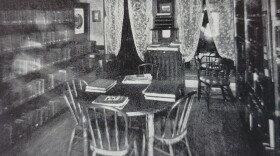Henry Hanson was a Rhinelander resident when he was called up for duty to serve in The Great World War as a captain and member of the 107th Supply Train, 32nd Division.
On a cold January day in 1918, Captain Hanson boarded the troop ship Tuscania at Hoboken, New Jersey. The three-year-old cruise liner tuned troop transport ship, was loaded with 2,013 army soldiers destined for Liverpool, England.
On February 5, just 13 days after it left the U.S., the Tuscania was stalked and torpedoed by a German U Boat – 77 off the coast of Ireland.
At the time of the attack, Rhinelander’s own Captain Henry C. Hanson was in one of the ship’s galleys. Henry had gone down to retrieve coffee for mumps patients on board. When he asked the galley steward to make a fresh pot, the attendant refused, since it was after mess hours. Captain Hanson was about to go to fisticuffs with the man over a fresh cup of Joe, when the boat was rocked by an explosion.
Reports of the time the torpedo struck vary, but Captain Hanson recalled that a surviving member of his unit who was knocked into the water by the blast, had his waterlogged watch stuck at 5:55 p.m.
With the lights aboard ship out, the two men made their way through a narrow passageway where fear caused several men to be trampled to death. He also witnessed two panicked soldiers slashing their way toward a lifeboat with knives when an officer shot them. Such was the scene aboard the sinking ship.
As the boat listed in the water, Henry made it to the relative safety of a lifeboat where he sat for more than two hours until they were picked up by a destroyer. There was no room on the ship for all of the rescued men, so they stood on the deck in the cold until 4 a.m. when they landed on the coast.
Of the men on board, 210 were said to have been lost. Of the survivors, almost 400 of them were from Wisconsin’s 32nd Division. Captain Hanson was the lone survivor from Rhinelander.
The torpedoing of the Tuscania was the first U.S. troop ship destroyed during the war, and caused outrage in the states, thereby ramping up the war effort.
Henry Hanson returned to Rhinelander after the war and became the second Chief of the Rhinelander Fire Department until 1939. During his tenure as fire chief, he witnessed one of Rhinelander’s most devastating fires in the burning of the CC Collins Mill where Hodag Park is today. He also advocated for a number of fire safety ordinances including the banning of wooden roofing shingles.
In his retirement years, Henry led a relatively quiet life by comparison, passing away in 1966. He is buried at Forest Home Cemetery in Rhinelander.
Source: Rhinelander Daily News, various articles from 1929-1960.










